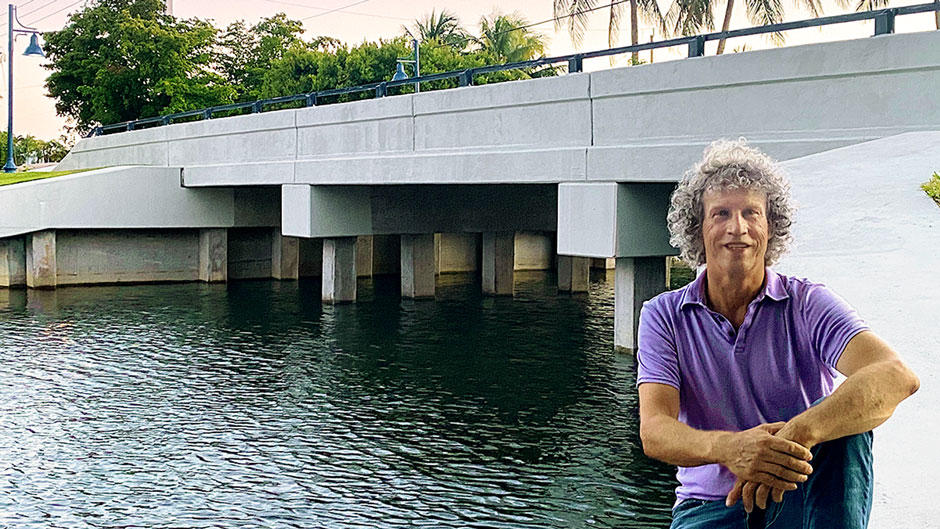Construction engineers working on the Luxor Hotel in Las Vegas faced a conundrum: how to prevent the 40-billion candlepower sky beam atop the pyramid-shaped hotel from incinerating the property.
To solve the problem, they borrowed a page from aerospace history, employing the same type of multilayer insulation used by NASA to cover the exterior of the Apollo 11 command module that carried the first men to walk on the moon.
“It looked a lot like crinkled tin foil, but the insulation worked flawlessly,” said Christian C. Steputat, one of the structural specialty spaceframe engineers who worked on the Luxor when it was built in the early 1990s.
A lot has changed since then. The Luxor is no longer the tallest hotel on the Las Vegas Strip, and Steputat is now a doctoral student in the University of Miami College of Engineering.
But what hasn’t changed is Steputat’s love of civil engineering.
From a high-rise building in Beijing to a 540-foot-tall replica of the Eiffel Tower in Las Vegas to the guitar-shaped Seminole Hard Rock Hotel and Casino in Hollywood, Florida, Steputat has worked as a civil engineer on just about every kind of design and construction project imaginable. He was part of a team that built an innovative seawall in Flagler Beach that protects sand dunes, adjacent properties, and a segment of State Road A1A from storm surge.
But it is a project in the small Broward County suburb of Lighthouse Point that is arguably the most important task on which he has worked. While the Ibis Bridge may not be as intriguing to look at as the Luxor, the 128-foot-long span that traverses the Ibis Waterway is helping to fulfill President Joe Biden’s ambitious goal of ramping up the nation’s infrastructure, with fixing ailing roadways and overpasses at the top of the list.
Under the president’s American Jobs Plan, 20,000 miles of highways, roads, and main streets will be upgraded; 10 of the most economically significant bridges in the U.S. in need of reconstruction will be mended; and 10,000 smaller bridges, like the Ibis Bridge, will be repaired.
As part of his doctoral research, Steputat documented the use of, and the partial prestressing process applied to, the special rebars used in the Ibis Bridge’s construction. Those rebars are made of glass fiber reinforced polymers (GFRP), which can be twice as strong as steel, yet four times as light.
“In older bridges made with steel rebars, boats, jet skis, and other watercraft that travel under them generate sea spray, which can eventually cause rust staining and corrosion,” Steputat explained. But GFRP rebars do not corrode. “You can basically stick them in saltwater, and they’ll never rust,” he said.
And that’s good news for the city of Lighthouse Point. The $2.4 million Ibis Bridge, which replaces an original span built in 1950, is expected to last a century, Steputat said.
Steputat also installed 10 wireless sensors in the bridge’s core and deck to monitor the strength, temperature, and humidity of the concrete, accessing the data via his smartphone. “We want to know how the concrete in the middle is behaving compared to the outer surfaces that get a lot of air circulation and cool the quickest,” he said.
Built by Miami-based Anzac Contractors through a Florida Department of Transportation initiative, the Ibis Bridge can help educate contractors still reluctant to use GFRP in their construction projects, Steputat believes.
“Most bridges are still built with the old-fashioned steel rebars,” he said. “Using GFRP technology can decrease maintenance costs, and it comes with longer service life. It’s starting to gain a foothold. Not as quickly as we’d like, so we have an obligation to educate not just the public but the construction industry at large.”
Having worked on design and construction projects on five continents, Steputat is passionate about educating others about the benefits of GFRP. With a mother who is an architect and a father who is an engineer, he grew up on construction sites, often climbing the scaffolding when his parents weren’t looking.
“I look at our planet in terms of sustainability and resilience,” said Steputat, a member of the American Society of Civil Engineers. “What can we do to make everything better and optimize our systems by using and reusing our available resources? That’s the future of our industry.”

